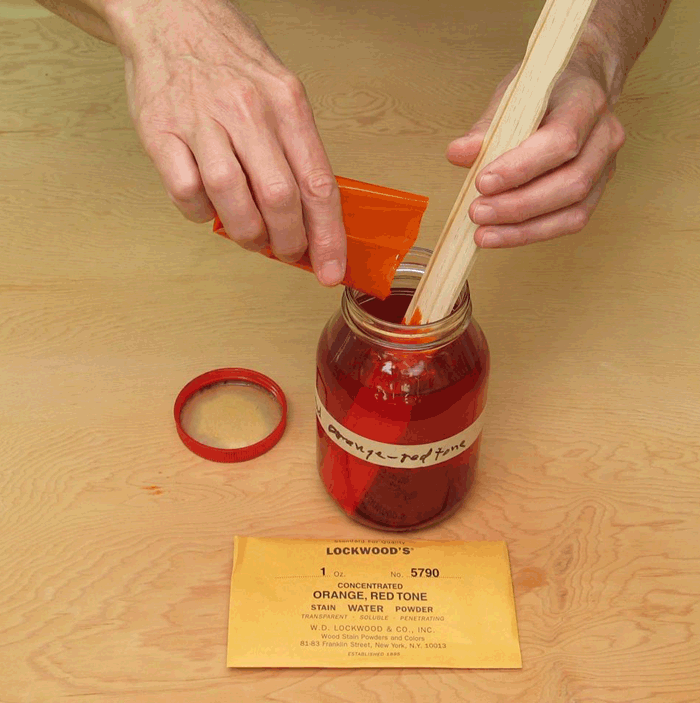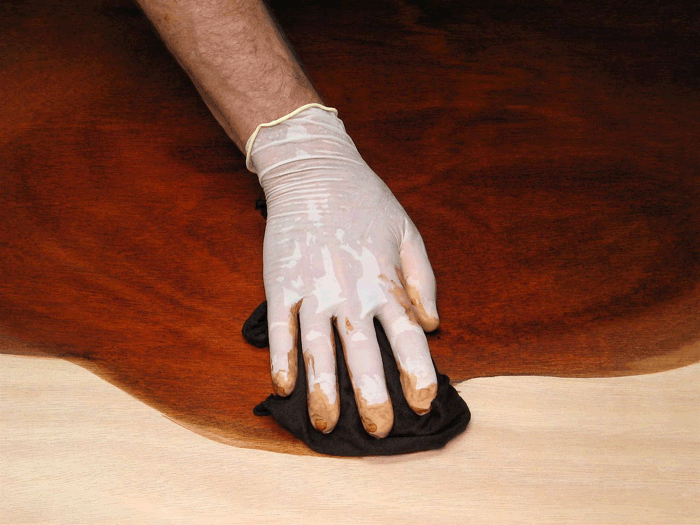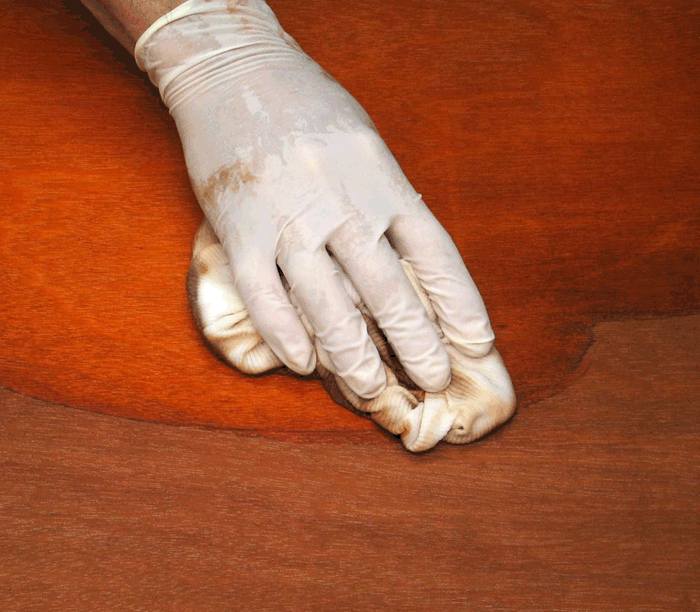How to Use W. D. Lockwood Dyes
Introduction
We carry the full line of the best wood dyes available in America. They're made by W. D. Lockwood, a company that has been supplying dyes to furniture makers since 1895 - far longer than any other existing company.
Common store-bought wood stains usually contain pigment and always contain a binder to glue the pigment to the wood. These stains sit mostly on top of the wood so they don't add much color unless you leave them thick - in which case they muddy the wood. By contrast, stand-alone dyes dissolved in water or alcohol penetrate everywhere along with the liquid, so the result is a deeper, richer, more vibrant coloring that better reveals the wood's natural beauty.
Common store-bought wood stains usually contain pigment and always contain a binder to glue the pigment to the wood. These stains sit mostly on top of the wood so they don't add much color unless you leave them thick - in which case they muddy the wood. By contrast, stand-alone dyes dissolved in water or alcohol penetrate everywhere along with the liquid, so the result is a deeper, richer, more vibrant coloring that better reveals the wood's natural beauty.
Lockwood dyes have two great advantages over other dyes on the market today:
- A much larger choice of colors in traditional wood tones. Lockwood got its start at the turn of the 20th century catering to the needs of the New York City furniture industry, which wanted to reproduce in new wood the colors of the aged wood found in early American and English furniture.
- The ability to lighten the dye (that is, remove a significant amount of the color) after you have applied it to the wood. This gives you greater control.
The dyes we carry dissolve in water, denatured alcohol, or oil.
We suggest using water-soluble dyes if you are applying the stain with a cloth or
brush and then wiping off the excess. Use alcohol-soluble dyes if you are
spraying and leaving the dye unwiped. (You can also spray water-soluble dyes if you like.)
Restorers also use the alcohol based dyes for tinting shellac for touchup.
The oil soluble dyes are used for tinting varnish and other oil based materials but are
in general not typically used for the regular staining of wood.
Safety Precautions
Safety is always important. While Lockwood dyes are generally safe, it is good
practice to wear gloves to protect the skin from absorbing dye and of course to keep your hands from getting
stained, and to wear a mask to avoid breathing in the dust.
MSDS sheets are available on-line for the
water based dyes.
A small point, no so much about safety but about cleanliness: remember, these dyes are DYES!! If you get them on any surface they will color that surface and be a devil to clean. It is good policy to lay down newspaper to protect your workspace from being accidentally stained.
A small point, no so much about safety but about cleanliness: remember, these dyes are DYES!! If you get them on any surface they will color that surface and be a devil to clean. It is good policy to lay down newspaper to protect your workspace from being accidentally stained.
How to Mix and Apply the Dye
- Dissolve the dye in the appropriate solvent (water or denatured alcohol).
For a standard color, add the ratio of one ounce of dye to one quart
of solvent and stir.
Add
more solvent to make a lighter color. Add less solvent to make a darker
color. (With water-soluble dyes, using hot water will make it possible
to dissolve more dye for a darker color. Using distilled water will
avoid any color changes that metal residue in tap water might cause,
though tap water should be all right in most locations.) Dissolve the
dye in a non-metal container such as a glass jar, with a lid to prevent
evaporation during storage. Strain the dye if you aren’t sure you’ve
dissolved all of it.

- With water-soluble dye, quickly wipe or brush the dye onto the wood.
(Wiping with a soaked rag or sponge is much faster than brushing and
is our suggested method. Be sure to wear gloves.) Wipe off the excess
dye before it dries. If the total surface area is large, divide it into
naturally smaller sections (tops, sides, doors, drawer fronts, etc.),
and complete one section at a time.

- With alcohol-soluble dye, spray the dye evenly and leave it. We recommend thinning the dye with three or more parts denatured alcohol and spraying a number of coats to avoid lap marks. Build the color slowly until you get what you want. (Spraying and not wiping is a technique that can be used to reduce blotching.)
- To blend sapwood with heartwood, apply more dye to the lighter areas. A spray gun provides the best control for feathering edges.
- Apply the finish in your a normal manner. If you are brushing water-based finish over water-soluble dye, seal the wood first with any other finish to avoid redissolving and smearing the dye, or spray the first coat using an aerosol containing water-based finish. If you are brushing shellac over alcohol-soluble dye, seal first with aerosol shellac.
- To warm or otherwise add color to water-based finish, add a little dissolved water-soluble dye to the finish.
- To add color to shellac, add a little dissolved alcohol-soluble dye to the finish.
- To make a sprayable colored finish, called a "toner," to use for minor adjustments to the color of already sealed wood, add about one part dissolved alcohol-soluble dye to one part shellac. Then thin the colored shellac with about six parts alcohol so each spray coat adds very little color and very little build. Then "sneak up" on the color you want with several sprayed coats.
- To use dye for coloring in dings and scratches, dip the tip of a small artists brush into some shellac and then pick up a tiny bit of the alcohol-soluble powder on the tip of the brush. Spread the concentrated color on paper or scrap wood until the color becomes even and about the intensity you want. Then touch the brush to the damaged area. When you get the color right, seal it in with clear finish.
- Before you attempt to dye any project you should test the specific sequence of dying and finishing to see if you like the result before you commit to the finish sequence for the entire piece. This way you can see how your wood, with your mixing of dye, and what you are using as a topcoat, the way you apply it will look when you are all done.
Getting the Color You Want (Blending)
Lockwood dyes come in scores of colors, so most likely we have the color
you want. But you have total control. You can blend any of the colors that
dissolve in the same solvent. (It’s best to do the blending with dissolved
dyes.) You can lighten the color after the dye has dried on the wood by
wiping with a cloth soaked with the appropriate
solvent
(water or denatured alcohol) and then wiping off the excess before it dries.
You can darken the color by applying another coat. You can change the color
by applying another color on top. If this makes the coloring too dark, lighten
it by removing some of it.


For tweaking stock colors, we suggest adding small amounts of dissolved concentrated pure colors.
- A little green will "cool" a reddish tint.
- A little black will "brown out" a reddish tint.
- A little red will "warm" a greenish tint.
- A little blue will change red to cordovan.
- A little yellow will make red more orange.
Dealing with Grain Raising
Water raises the grain of wood making it feel rough. There are two ways to deal
with this.
- Pre-raise the grain by wiping the surface with a wet cloth. Allow the wood to dry thoroughly (best overnight). Then sand the roughness smooth using 280-, 320- or 400-grit sandpaper, whichever is most efficient for your situation. Grain raises to different degrees of roughness on different woods.
- Apply the dye without pre-raising the grain and then "bury" the raised grain with your first coat of finish (the sealer coat). Then sand it smooth just as you would normally sand the first coat.
Conclusion
Finishers have colored furniture since - well, forever. There are bunches of reasons for
staining your furniture: making wood look nicer, matching existing pieces, evening out the color of a
the wood used in a piece, making the wood look like a nicer piece of the same species, making wood
look like a more expensive species, and just putting many more colors into a piece of
furniture. A popular technique is dyeing wood bright colors and use them in inlay
and marquetry. There are lots
of other reasons, we are sure, but certainly our point is that you can be
incredibily creative with
wood dyes. The possibilities
are endless. That's why we stock the entire range of W. D. Lockwood dyes.
We want to present all your options
and we leave it to you to make some really exciting furniture.
|
Hours: M-F 9:00-5:00, closed Sat,Sun Our Guarantee & Return Policy Shipping and Sales Tax Info Privacy Policy Holiday Calendar |
|
Contact Us:
Email: support@toolsforworkingwood.com Phone: 800-426-4613 or 718-499-5877 Visit Us in Brooklyn: Directions to Our Showroom © 1999-2019 toolsforworkingwood.com Powered by 01 Inc. Coded entirely in NYC |


